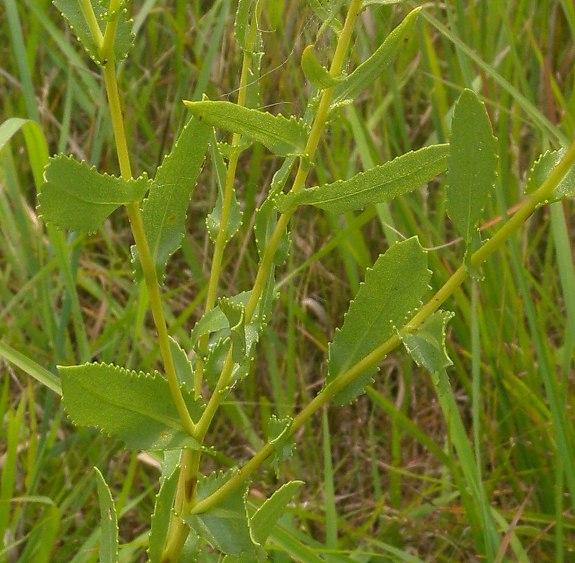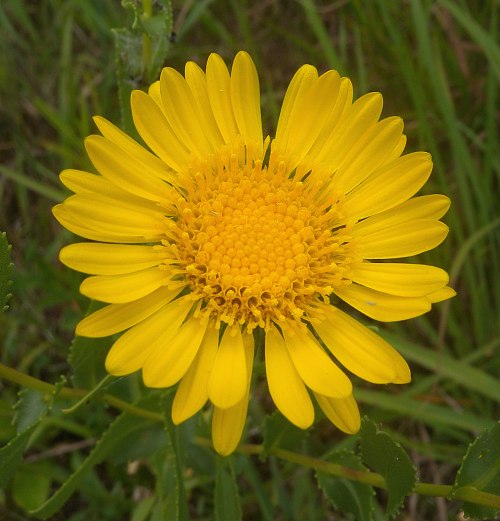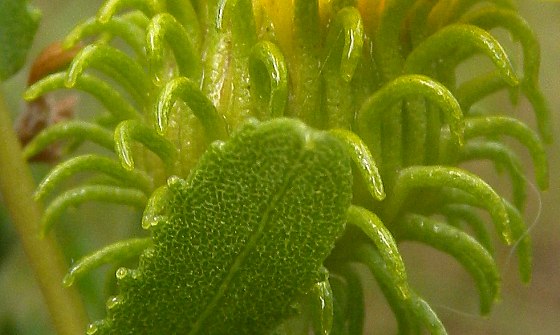
The petaloid rays of the flowerhead are bright yellow and short-oblong to oblong in shape; they are widely spreading when the flowerhead is fully open. The disk florets form a dense circular head; their corollas are about 4-6 mm. long, bright yellow, and short-tubular in shape with 5 erect lobes. These lobes have a broad, but low, triangular shape. Both ray florets and disk florets can produce fertile seeds. Surrounding the base of the flowerhead, there are light-medium floral bracts (phyllaries) in several series. These erect bracts have a thick filiform (worm-like) shape and their upper tips are strongly recurved (less often, their upper tips may be twisted). The floral bracts are hairless, but finely mottled from resinous glands, like the leaves, and they are slightly sticky to the touch. The blooming period occurs from mid-summer into early autumn, lasting 1½–2 months for a colony of plants at a specific locality. Afterwards, fertile florets are replaced by 4-angled oblanceoloid achenes that are about 1.5–4 mm. long. These achenes are light brown, straight to slightly curved, and they have narrow vertical ridges along their sides. The apex of each achene has 2 or more scales or awns that are early-deciduous. The root system consists of a stout taproot with abundant fibrous roots emerging from its sides. Although this taproot can extend up to 6' into the ground, it is usually much shorter than this. This plant reproduces by reseeding itself.

Cultivation: The preference is full sun, dry conditions, and a barren soil containing clay, gravel, or sand, although this plant becomes larger in size when the soil contains loam and more moisture. The seeds germinate more readily when they are exposed to 10-weeks of cold moist stratification indoors, or they are planted outdoors in exposed topsoil during the autumn.
Range & Habitat: The non-native Curlycup Gumweed (Grindelia squarrosa squarrosa) is occasional in northern Illinois, uncommon in central Illinois, and rare or absent from the southern section of the state (see Distribution Map). It is adventive from the Great Plains region further to the west, where it occurs in prairies and open disturbed ground. However, Curlycup Gumweed has expanded its range further to the west and further to the east; it has also spread to areas that lie east of Illinois. Habitats include upland prairies, disturbed areas along the border of prairies, abandoned fields, pastures, roadsides, areas along railroads, and dry exposed waste areas. Areas with a history of disturbance are strongly preferred. In Illinois, this plant is not considered invasive, with the possible exception of overgrazed pastures.

Faunal Associations: The nectar and pollen of Curlycup Gumweed's flowerheads attract primarily bees, including little carpenter bees (Ceratina spp.), leaf-cutting bees (Megachile spp.), Halictid bees (Lasioglossum spp.), alkali bees (Nomia spp.), Andrenine bees (Andrena spp.), and dagger bees (Calliopsis spp.). Other floral visitors include adult bee flies (Bombyliidae), and the adults of Chauliognathus pennyslvanicus (Goldenrod Soldier Beetle), Diabrotica barberi (Northern Corn Rootworm), and Diabrotica undecimpunctata (Spotted Cucumber Beetle). In addition to feeding on the pollen, the latter two beetle species also gnaw destructively on the florets of the flowerheads (Reed, 1993; Graenicher, 1909; Krombein et al., 1979; Williams, 2006; Discover Life, accessed 2015; Campbell & Meinke, 2006). Other insects that feed destructively on this plant include Pissonotus delicatus (a planthopper); larvae of Calycomyza platyptera (a leaf-mining fly); Chlorochroa uhleri (Uhler's Stink Bug); Atarsos grindeliae, Illinoia grindeliae palmeri, and Uroleucon richardsi (aphid species); flowerhead-feeding larvae of Heliothis phloxiphaga (Darker-spotted Straw Moth), Homoeosoma electellum (Sunflower Moth), and Schinia mortua (Mortua Flower Moth); and Hesperotettix speciosus (Western Grass-green Grasshopper), Hesperotettix viridis (Meadow Purple-striped Grasshopper), Melanoplus confusus (Little Pasture Grasshopper), and Melanoplus femurrubrum (Red-legged Grasshopper); see Bossert (2011), Spencer & Steyskal (1986), Rider (accessed 2009), Robinson & Bradley (1965), Blackman & Eastop (2013), Natural History Museum (accessed 2010), Brust et al. (2008), Campbell et al. (1974), and Vickery & Kevan (1985) for more information. The foliage of Curlycup Gumweed is unpalatable to mammalian herbivores (horses, cattle, sheep, etc.) and rarely eaten. Its foliage is unpleasant-tasting because it contains tannins, volatile oils, resins, bitter alkaloids, and glucosides. However, in some areas of western United States, the chicks of Sage Grouse feed on this plant to a significant extent (Walsh, 1993).

Photographic Location: Along a path at the disturbed edge of a prairie in McHenry County, Illinois.
Comments: The resinous foliage of Curlycup Gumweed (Grindelia squarrosa) may enable it to survive periods of drought by reducing the emission of water vapor from transpiration. Across its range, different varieties of Curlycup Gumweed have been described. The typical variety, Grindelia squarrosa squarrosa, has been described here. There is also a variety that lacks petaloid rays on the flowerheads, referred to as Grindelia squarrosa nuda. Another variety of this plant, Grindelia squarrosa serrulata, has more narrow leaves. These atypical varieties of Curlycup Gumweed, and other gumweed species (Grindelia spp.), have a more western distribution and they have not been found in Illinois. Other gumweed species can be easily distinguished from this plant by the relatively straight floral bracts (phyllaries) surrounding the bases of their flowerheads. Other common names of Grindelia squarrosa include Curlytop Gumweed and Tarweed.